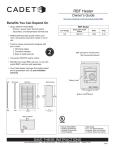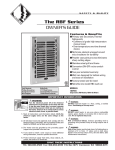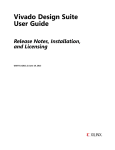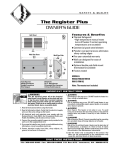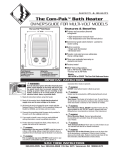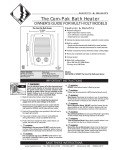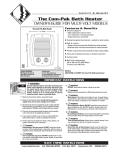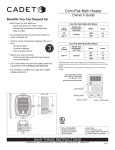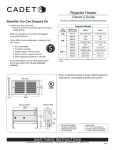Download Cadet RBF Series Troubleshooting guide
Transcript
The RBF Series OWNER’S GUIDE Features & Benefits TOOLS REQUIRED: • Phillips Screwdriver • Straight Screwdriver Wire Strippers Utility Knife • Insulated Wire Connectors • • ■ Retrofits into model RBC wall can or use with wall can model RBFC ■ Primary and Secondary Thermal Safeguards • Robust, heavy duty high temperature manual power reset • Over-temperature one-time thermal fuse ■ Nichrome element wrapped around mica insulators for durability ■ Powder coat paint process eliminates sharp cutting edges ■ Stainless steel grill and frame ■ Convenient ON-OFF rocker switch control ■ Two year extended warranty ■ Factory tested and UL listed MODELS: RBF101 (Supersedes Models RB101 & RB121) IMPORTANT INSTRUCTIONS WARNING 7. WARNING! Overheating or fire may occur. DO NOT install the heater in Turn the electrical power off at the electrical a floor, ceiling, or behind doors. panel board (circuit breaker or fuse box) and lock or tag the panel board door to prevent someone 8. WARNING! from turning on power while you are working on Fire or explosion may occur. DO NOT install heater in any the heater. Failure to do so could result in area where combustible vapors, gases, liquids, or excessive serious electrical shock, burns, or possible death. lint or dust are present. 1. Read all instructions before using this heater. 9. WARNING! Burn Hazard. This heater is hot when in use. To avoid burns, do not let bare skin touch hot surfaces. Use extreme caution when any heater is used by or near children or invalids. 3. All electrical work and materials must comply with the National Electric Code (NEC), the Occupational Safety and Health Act (OSHA), and all state and local codes. 10. WARNING! Risk of Electrical Shock. Connect grounding lead to grounding screw provided. Keep all foreign objects out of heater. 4. Connect the grounding screw provided in the wall can to the supply ground wire. 11. 2. Read all information labels. Verify that the electrical supply wires are the same voltage as the heater. 5. If you need to install a new circuit or need additional wiring information, consult a qualified electrician. 6. Protect electrical supply from kinks, sharp objects, oil, grease, hot surfaces or chemicals. WARNING! Risk of Fire. Do not block heater. Heater must be kept clear of all obstructions: a minimum of 3 feet in front, 6 inches above and on both sides. Heater must be kept clean of lint, dirt and debris. (See Maintenance Instructions). 12. Use this heater only as described in this manual. Any other use not recommended by the manufacturer may cause fire, electrical shock, or injury to persons. SAVE THESE INSTRUCTIONS www.cadetco.com Tel: 360-693-2505 P.O. Box 1675 Vancouver, WA 98668-1675 READ ALL INSTRUCTIONS AND SAFETY INFORMATION Installation Instructions Part One PLACEMENT: UL approved for vertical installation only. CONTROL OF HEATER: ON-OFF control built into product. IMPORTANT! It is extremely important you verify the electrical supply wires are the same voltage as the heater (i.e. 120 volt heater to 120 volt power supply and 240 volt heater to 240 volt power supply). If replacing an existing heater, check the labels of the old heater and replace using the same voltage. Hooking a 240 volt heater to a 120 volt power supply will drastically reduce the heater's output. Hooking a 120 volt heater to a 240 volt power supply will destroy the heater. Connecting your heater to an incompatible power supply will void the warranty. How do I install for new construction? STEP 1 How do I install in an existing wall? STEP 1 Mount The Wall Can The wall can is designed to fit between two standard 16 inches on-center studs. UL requires a minimum clearance of 6 inches adjacent vertical surfaces such as walls, shelving, drapes, etc. Manufacturer recommends 12 inches from finished floor and adjacent surfaces. (Note: Front edge of wall can must be flush with finished wall. If installing on unfinished wall; face of wall can must extend from face of stud to allow for thickness of sheetrock.) Secure the wall can to the studs with two screws or nails, right or left hand mounting (See Figure 1). Cut Hole In Wall Cut a hole 10¼ inches wide by 16¾ inches high next to wall stud. UL requires a minimum clearance of 6 inches adjacent vertical surfaces, such as walls, shelving, drapes, etc. Manufacturer recommends 12 inches from finished floor and adjacent surfaces (See Figure 2). WALL CAN SCREW Figure 2 STEP 2 GROUND WIRE GROUND SCREW SCREW SUPPLY STEP 3 Mount The Wall Can The wall can is designed to fit between two standard 16 inches on-center studs. Note: Front edge of wall can must be flush with finished wall (See Figure 2). Secure the wall can to the studs with two screws or nails, right or left hand mounting (See Figure 1). Figure 1 STEP 2 Route Supply Wires Route supply wire from circuit breaker through opening in bottom of wall can and secure with strain relief connector, leaving 6 inches to 10 inches wire lead for later use. Connect supply ground wire to grounding screw in wall can (See Figure 1). Route Supply Wires Route supply wire from circuit breaker through opening in bottom of wall can and secure with strain relief connector, leaving 6 inches to 10 inches wire lead for later use. Connect supply ground wire to grounding screw in wall can (See Figure 1). Part Two STEP 1 2 Warranty is void if any material is sprayed on the element or blower. Use paintmask provided if walls are to be textured or painted. Insert Heater Assembly Into Wall Can Install spring clips on wall can edge, two at the top and two at the bottom (See Figure 3). Lay heater assembly on its front surface and position so rocker switch will be installed at bottom of wall can (See Figure 4). Make the connection of the supply wires to the lead wires from the rocker switch. Position the heater assembly to fit adapter plate to the surface of the wall can (See Figure 3). Be sure all lead wires are inside the wall can before securing heater assembly. (Use the four #10 32 x ½ inch machine screws; two at top and two at bottom.) STEP 2 Install Grill Frame and Grill Remove protective film from frame and grill before installing. Place grill frame outside top and bottom flanges of the heater assembly. Place grill over frame and secure with the four finishing washers and four #10 x 1½ inch Phillips oval head sheet metal screws (See Figure 3). Start all four screws before tightening (Note: Over tightening screws may damage grill). Installation Instructions Retrofitting RBF101 as Replacement for RB Heaters Figure 4 Figure 3 RB/RBF Wall Can Supply Wires Rocker Switch For installation in newer RB/RBF wall can only. STEP 1 A. Remove Existing Heater WARNING! Before removing grill, turn the electrical power off at the electrical panel board (circuit breaker or fuse box). Lock or tag the panel board door to prevent someone from accidentally turning the power on while you are working on the heater. Failure to do so could result in serious electrical shock, burns, or possible death. B. It is important that you verify power has been turned off and no power is going to the heater before proceeding. Circuit breakers are often not marked correctly and turning the wrong breaker off could mean electricity is flowing to the heater, even if the heater does not appear to be working. If you are uncomfortable working with electrical appliances, unable to follow these guidelines, or do not have the necessary equipment, consult a qualified electrician. C. Once you verify the power has been turned off correctly, proceed to next step. D. Remove screws and take off grill. STEP 2 Install Heater Assembly Into Wall Can Install spring clips on wall can edge, two at the top and two at the bottom (See Figure 3). Lay heater assembly on its front surface and position rocker switch to be installed at bottom of wall can (See Figure 4). Make the connection of the supply wires to the lead wires from the rocker switch. Position the heater assembly to fit adapter plate to the surface of the wall can (See Figure 3). Important: Push wires into bottom of wall can during insertion. Be sure that wires are not caught between motor and wall can. Attach assembly using the four #10 32 x ½ inch machine screws; two at top and two at bottom. STEP 3 Install Grill Frame and Grill Remove protective film from frame and grill before installing. Place grill frame outside top and bottom flanges of the heater assembly. Place grill over frame and secure with the four finishing washers and four #10 x 1½ inch Phillips oval head sheet metal screws (See Figure 3). Start all four screws before tightening. (Note: Over tightening screws may damage grill.) E. Separate supply wire and lead wire connections. 3 RBF WIRING DIAGRAM WARNING Risk of Electrical Shock. Connect grounding lead to grounding screw provided. Keep all foreign objects out of heater. WARNING Risk of Fire. Heater must be kept clear of all obstructions: a minimum of 3 feet in front; 6 inches on both sides and above. Heater must be kept clean of lint, dirt and debris. WARNING Turn the electrical power off at the electrical panel board (circuit breaker or fuse box) and lock or tag the panel board door to prevent someone from turning on power while you are working on the heater. Failure to do so could result in serious electrical shock, burns, or possible death. 4 Manual Power Reset High Temperature Limit Operation & Maintenance How to operate your heater Once installation is complete and power has been restored, turn the heater switch on. Important: The heater will remain on until it is manually turned off. Maintenance As needed, or every six months, minimum. 1. WARNING! Before removing grill, turn the electrical power off at the electrical panel board (circuit breaker or fuse box). Lock or tag the panel board door to prevent someone from accidentally turning the power on while you are working on the heater. Failure to do so could result in serious electrical shock, burns, or possible death. 2. It is important that you verify power has been turned off and no power is going to the heater before proceeding. Circuit breakers are often not marked correctly and turning the wrong breaker off could mean electricity is flowing to the heater, even if the heater does not appear to be working. If you are uncomfortable working with electrical appliances, unable to follow these guidelines, or do not have the necessary equipment, consult a qualified electrician. 3. Once you verify the power has been turned off correctly, proceed to next step. 4. Remove screws and take off grill. 5. Wash grill with hot soapy water and dry immediately. 6. While holding fan (to avoid damage or bending), use a hair dryer or vacuum on blow cycle to blow debris through the top element (do not touch element). 7. Vacuum fan area without touching the elements. 8. Replace grill and secure with screws. 9. Turn power back on at the electrical panel board. About the Heater Temperature-Limiting Controls The heater is protected by two temperature-limiting controls. Both controls are integral parts of the element assembly. The first is a manual power reset limit control, designed to open the heater circuit when excessive operating temperatures are detected. The problem must be assessed and the limit must be reset to resume operation. Further protection is provided by a secondary over-temperature fuse, which will open the heater circuit in severe over-temperature conditions, or in the event of component failure. If this occurs, the heater must be repaired or replaced. RESETTING THE MANUAL POWER RESET LIMIT CONTROL If the manual power reset limit has opened the heater circuit due to excessive operating temperatures, the heater will not work until it is reset. This can be done at the ON/OFF rocker switch control or the circuit breaker controlling the heater. To reset heater at the ON/OFF rocker switch control 1. Change rocker switch control to OFF position. 2. Allow the unit to cool for at least 10 minutes. 3. Resolve the problem causing the limit to trip (typically the heater is blocked or needs cleaning, see Maintenance Instructions). 4. Change rocker switch control to the ON position. The heater should come back on. To reset heater at the circuit breaker 1. Trip the breaker by switching it to the OFF position. 2. Allow the unit to cool for at least 10 minutes. 3. Resolve the problem causing the limit to trip (typically the heater is blocked or needs cleaning, see Maintenance Instructions). 4. Restore power to the heater by switching the breaker to the ON position. 5. The heater should come back on. Note that resetting the manual power reset control may not restore heater operation if a severe over-temperature condition has occurred. See the Troubleshooting Guide below for more information. Troubleshooting Chart CONSULT LOCAL ELECTRICAL CODES TO DETERMINE WHAT WORK MUST BE PERFORMED BY QUALIFIED ELECTRICAL SERVICE PERSONNEL. Symptom Problem Solution Breaker trips immediately upon energizing heater. 1. Incorrect supply voltage. 2. Overloaded circuit. 1. Verify that supply voltage matches the heater rating. 2. The total amperage of all heaters on a branch circuit must not be more than 80% of the amperage rating of the circuit breaker and supply wire ratings. Reduce the number of heaters on the circuit. 3. Shorted supply or heater wires may be accompanied by severe sparking. Inspect all supply and heater wiring insulation for damage. Do not reset the circuit breaker until all electrical shorts have been repaired. 4. Replace the circuit breaker. 3. A short circuit exists in the supply or heater wiring. 4. Defective circuit breaker. Heater fan operates, but does not discharge warm air. 1. Insufficient element temperature. 2. Incorrect supply voltage. 3. Element has failed. Heater discharges smoke or emits a burnt odor. 1. Dust, lint or other matter has 1. Clean heater (See “Operation & Maintenance” section for instructions). accumulated inside heater. Element heats for a moment without the fan turning, then immediately stops heating. 1. Defective motor or internal connection. 2. Fan or motor jammed. 1. Heater or fan motor requires replacement. Heater does not run. 1. Heater has tripped the power reset high-temperature control. 2. Heater has tripped the secondary over-temperature fuse. 3. Power not on at the circuit breaker. 4. Broken or poorly connected wire(s) to heater. 5. Defective rocker switch control. 1. Follow instructions in the “Operation & Maintenance” section for “Resetting the Manual Power Reset Limit Control.” 1. Allow a few moments for element to reach operating temperature. 2. Verify that supply voltage matches the heater rating. 3. Replace element. 2. Remove obstruction and follow instructions in the “Operations & Maintenance” section for “Resetting the Manual Power Reset Limit Control.” Test heater operation. If heater does not run, heater requires repair or replacement. 2. A severe over-temperature condition has occurred. Repair or replace heater. 3. Turn on the correct circuit breaker in the main panel. 4. Turn off power at circuit breaker. Check supply wire continuity and proper connection to heater wires. 5. The entire heater, or any of its components may be checked for continuity to determine the cause of any problems. Repair or replace the heater. Warranty Maintenance 7. IN THE EVENT CADET ELECTS TO REPLACE ANY PART OF YOUR For more effective and safer operation and to prolong the life of the CADET PRODUCT, THE REPLACEMENT PARTS ARE SUBJECT heater, read the Owner’s Guide and follow the maintenance instructions TO THE SAME WARRANTIES AS THE PRODUCT. THE INSTALLATION included with each heater. Failure to properly maintain the heater will OF REPLACEMENT PARTS DOES NOT MODIFY OR EXTEND void any warranty and may cause the heater to function improperly. THE UNDERLYING WARRANTIES. REPLACEMENT OR REPAIR Warranties are non transferable and apply to original consumer OF ANY CADET PRODUCT OR PART DOES NOT CREATE ANY only. Warranty terms are set out below. NEW WARRANTIES. 8. These warranties give you specific legal rights, and you may also LIMITED TWO-YEAR WARRANTY: Cadet will repair or replace any have other rights which vary from state to state. Cadet neither RBF Series element or motor found to be defective or malfunctioning assumes, nor authorizes anyone to assume for it, any other obligation from first date of purchase through the second year. or liability in connection with its products other than as set out herein. These warranties do not apply: 1. Damage occurs to the product through improper installation or incorrect supply voltage; 2. Damage occurs to the product through improper maintenance, misuse, abuse, accident, or alteration; 3. The product is serviced by anyone other than Cadet; 4. If the date of manufacture of the product cannot be determined; 5. If the product is damaged during shipping through no fault of Cadet. 6. CADET’S WARRANTY IS LIMITED TO REPAIR OR REPLACEMENT AS SET OUT HEREIN. CADET SHALL NOT BE LIABLE FOR DAMAGES SUCH AS PROPERTY DAMAGE OR FOR CONSEQUENTIAL DAMAGES AND/OR INCIDENTAL EXPENSES RESULTING FROM BREACH OF THESE WRITTEN WARRANTIES OR ANY EXPRESS OR IMPLIED WARRANTY. If you believe your Cadet product is defective, please contact Cadet Manufacturing Co. at 360-693-2505, during the warranty period, for instructions on how to have the repair or replacement processed. Warranty claims made after the warranty period has expired will be denied. Products returned without authorization will be refused. Parts and Service Visit http://support.cadetco.com for information on where to obtain parts and service. Reduce-Reuse-Recycle This product is made primarily of recyclable materials. You can reduce your carbon footprint by recycling this product at the end of its useful life. Contact your local recycling support center for further recycling instructions. ©2009 Cadet Manufacturing Co. Printed in U.S.A. Rev. 7/11 #720196 5 The RBF Series GUÍA PARA EL PROPIETARIO Características y Beneficios ■ ■ ■ ■ ■ ■ ■ ■ HERRAMIENTAS NECESARIAS: • Destornillador Phillips • Destornillador plano • • • Pelacables Cuchillo multiuso Conectores de alambre aislados Calza en la cámara de pared del modelo RBC o bien puede usarlo con la cámara de pared del RBFC Protecciones térmicas primarias y secundarias • Resistente reglaje eléctrico manual de alta temperatura para servicio pesado • Fusible térmico de sobretemperatura de operación única Elemento de nicromo envuelto en aislantes de mica para brindar durabilidad Proceso de pintado con cobertura pulverizada que elimina los bordes filosos cortantes Rejilla y bastidor de acero inoxidable Cómodo control de interruptor basculante ON-OFF Garantía extendida de dos años Probado en fábrica y aprobado por UL MODELOS: RBF101 (supedita los modelos RB101 y RB121) INSTRUCCIONES IMPORTANTES ADVERTENCIA Desconecte la electricidad en el tablero del panel eléctrico (caja de cortacircuitos o fusibles) y trabe o coloque un cartel en la puerta del tablero del panel para evitar que alguien vuelva a conectar la energía mientras se esté trabajando en el calentador. De lo contrario podrían producirse graves golpes eléctricos, quemaduras e incluso la muerte. 7. ¡ADVERTENCIA! Podrían producirse explosiones o incendios. NO instale el calentador en áreas donde exista la presencia de vapores, gases o líquidos combustibles o exceso de pelusas o polvo. 8. ¡ADVERTENCIA! Podrían producirse explosiones o incendios. El calentador está caliente y contiene piezas que producen arcos voltaicos o chispas. No lo instale en áreas donde exista la presencia de vapores, gases o líquidos combustibles o exceso de pelusas o polvo. 1. Lea todas las instrucciones antes de usar este calentador. 9. ¡ADVERTENCIA! Riesgo de quemaduras. Este calentador se calienta mucho 2. Lea todas las etiquetas que contengan información. Verifique cuando está en uso. Para evitar quemaduras, no lo toque con que todos los cables de suministro eléctrico sean del mismo su piel descubierta. Tenga mucho cuidado al utilizar cualquier voltaje que el calentador. tipo de calentador en presencia de niños o personas inválidas. 3. Todo trabajo y materiales eléctricos deben cumplir con el Código Eléctrico Nacional (“NEC”, por su sigla en inglés), 10. ¡ADVERTENCIA! con la Ley de Seguridad y Salud Ocupacional (“OSHA”, por Riesgo de electrocución. Conecte el conductor a tierra al su sigla en inglés) y con todos los códigos estatales y locales. tornillo de puesta a tierra suministrado. Evite que entren objetos extraños al calentador. 4. Conecte el tornillo de puesta a tierra que viene en la cámara de pared al cable de conexión a tierra del suministro. 11. ¡ADVERTENCIA! 5. Si se debe instalar un nuevo circuito o se necesita información Riesgo de incendio. No bloquee el calentador. El calentador adicional sobre el cableado, consulte a un electricista calificado. debe mantenerse sin obstrucciones: un mínimo de 3 pies por delante, 6 pulgadas por encima y en cada costado. Los 6. Evite que los cables de suministro eléctrico se retuerzan calentadores deben mantenerse sin pelusas, suciedad ni o entren en contacto con objetos afilados, aceite, grasa, residuos. (Consulte las instrucciones de mantenimiento). superficies calientes o sustancias químicas. 12. Use este calentador sólo como se describe en este manual. Todo otro uso no recomendado por el fabricante puede causar incendios, descargas eléctricas o lesiones personales. CONSERVE ESTAS INSTRUCCIONES www.cadetco.com Tel: 360-693-2505 P.O. Box 1675 Vancouver, WA 98668-1675 ¡IMPORTANTE! Es extremadamente importante verificar que los cables de suministro eléctrico sean del mismo voltaje que el calentador (es decir, un calentador de 120 voltios con un suministro de energía de 120 voltios y un calentador de 240 voltios con un suministro de energía de 240 voltios). Si va a reemplazar un calentador existente, revise las etiquetas del calentador antiguo y sustitúyalo por otro del mismo voltaje. Si se conecta un calentador de 240 voltios a un suministro de energía de 120 voltios, se reducirá drásticamente el rendimiento del calentador. Si se conecta un calentador de 120 voltios a un suministro de energía de 240 voltios, se destruirá el calentador. Si se conecta el calentador a un suministro de energía incompatible, se anulará la garantía. La garantía pierde su validez si se rocía algún producto en el elemento o en el soplador. Utilice la máscara para pintura proporcionada si es que las paredes se pintarán o se les dará textura. 8 Instrucciones para la instalación Parte Uno UBICACIÓN: Aprobado por UL sólo para instalación vertical. CONTROL DEL CALENTADOR: Control de ENCENDIDO-APAGADO incorporado en el producto. ¿Cómo se instala el calentador en una construcción nueva? ¿Cómo se instala el calentador en una pared existente? PASO 1 Corte el orificio en la pared PASO 1 Montaje de la cámara de pared La cámara de pared fue diseñada para calzar entre dos puntales estándar ubicados a 16 pulgadas entre sí (centro a centro). UL exige un espaciado mínimo de 6 pulgadas adyacente a las superficies verticales tales como paredes, estantes, cortinas, etc. El fabricante recomienda 12 pulgadas desde el piso acabado y las superficies adyacentes. (Nota: El borde delantero de la cámara de pared debe quedar alineado con la pared acabada. Si ha de instalar el producto en una pared no terminada, la superficie de dicha pared debe extenderse desde la cara del puntal a fin de dejar espacio para la lámina de yeso.) Fije la cámara de pared a los puntales con dos tornillos o clavos, ya sea para montaje a la derecha o a la izquierda (vea la figura 1). Corte un orificio de 10¼ pulgadas de ancho por 16¾ de alto al lado del puntal de la pared. UL exige un espaciado mínimo de 6 pulgadas adyacente a las superficies verticales tales como paredes, estantes, cortinas, etc. El fabricante recomienda 12 pulgadas desde el piso acabado y las superficies adyacentes (vea la figura 2). PARED ADYACENTE LEA TODAS LAS INSTRUCCIONES E INFORMACIÓN ACERCA DE LA SEGURIDAD CÁMARA DE PARED TORNILLO Figura 2 PASO 2 Dirija los alambres de suministro ALAMBRE DE PUESTA A TIERRA Tienda el cable de suministro desde el cortacircuito a través de la abertura hasta la base de la cámara de pared, y afiáncelo con un conector con alivio de tensión, dejando 6 a 10 pulgadas de cable de conexión para uso posterior. Conecte el cable de suministro a tierra al tornillo de puesta a tierra situado en la cámara de pared (vea la figura 1). TORNILLO DE PUESTA A TIERRA SCREW ALAMBRES DE SUMINISTRO Figura 1 PASO 2 Dirija los alambres de suministro Tienda el cable de suministro desde el cortacircuito a través de la abertura hasta la base de la cámara de pared, y afiáncelo con un conector con alivio de tensión, dejando 6 a 10 pulgadas de cable de conexión para uso posterior. Conecte el cable de suministro a tierra al tornillo de puesta a tierra situado en la cámara de pared (vea la figura 1). PASO 3 Montaje de la cámara de pared La cámara de pared fue diseñada para calzar entre dos puntales estándar ubicados a 16 pulgadas entre sí (centro a centro). Nota: El borde delantero de la cámara de pared debe quedar alineado con la pared acabada (ver figura 2). Fije la cámara de pared a los puntales con dos tornillos o clavos, ya sea para montaje a la derecha o a la izquierda (vea la figura 1). Parte dos PASO 1 Inserte el conjunto del calentador en la cámara de pared Instale las presillas a resorte en el borde de la cámara de pared, dos en la parte superior y dos en al inferior (Consulte la figura 3). Ponga el conjunto del calentador sobre su superficie delantera y colóquelo de modo que el interruptor basculante se instale en la parte inferior de la cámara de pared (consulte la figura 4). Haga la conexión de los alambres de suministro a los alambres conductores provenientes del interruptor basculante. Coloque el conjunto del calentador para que calce con la placa adaptadora en la superficie de la cámara de pared (vea la figura 3). Cerciórese de que todos los alambres conductores estén en el interior de la cámara de pared antes de afianzar el conjunto del calentador. (Use los cuatro tornillos maquinados No. 10 32 x ½ pulg.; dos en la parte superior, y dos en la inferior). PASO 2 Instale la rejilla y su bastidor Retire la película protectora de la rejilla antes de instalarla. Coloque el bastidor de la rejilla fuera de las bridas de arriba y abajo del conjunto del calentador. Coloque la rejilla sobre el bastidor y fíjela con las cuatro arandelas protectoras y los cuatro tornillos Phillips No. 10 x 1½ pulg. de cabeza ovalada para láminas metálicas (vea la figura 1). Instale los cuatro tornillos antes de apretarlos (Nota: Si aprieta en exceso los tornillos puede dañar la rejilla.) Instrucciones para la instalación Calce del RBF101 como reemplazo para los calentadores RB Figura 3 Figura 4 Presilla a resorte Cámara de pared RB/RBF Conjunto del calentador Bastidor de la rejilla Alambres conductores Rejilla Alambre de puesta a tierra Alambres de suministro Interruptor basculante Tornillo del conjunto del calentador Para instalación sólo en la cámara de pared RB/RBF. Arandela Tornillo de la rejilla PASO 1 Retire el calentador actual: A. ¡ADVERTENCIA! Antes de quitar la rejilla, desconecte la electricidad en el tablero del panel eléctrico (cortacircuito o caja de fusibles). Trabe o coloque un cartel en la puerta del tablero del panel para evitar que alguien conecte accidentalmente la energía mientras se esté trabajando en el calentador. De lo contrario podrían producirse graves golpes eléctricos, quemaduras e incluso la muerte. B. Antes de proceder, es importante que usted verifique que se haya desconectado la alimentación y que el calentador no reciba energía. Los cortacircuitos no suelen estar correctamente marcados, y apagar el incorrecto podría significar que sigue fluyendo electricidad al calentador, aun cuando éste parezca no estar funcionando. Si no se siente cómodo al trabajar con artefactos eléctricos, no está en condiciones de acatar estas pautas o no cuenta con los equipos necesarios, solicite los servicios de un técnico electricista calificado. C. Una vez que verifique que se ha apagado la alimentación correctamente, prosiga con el paso siguiente. D. Retire los tornillos y extraiga la rejilla. E. Separe las conexiones de los alambres de suministro y de los alambres conductores. el conjunto del calentador PASO 2 Instale en la cámara de pared Instale las presillas a resorte en el borde de la cámara de pared, dos en la parte superior y dos en al inferior (Consulte la figura 3). Ponga el conjunto del calentador sobre su superficie delantera, coloque el interruptor basculante que se ha de instalar en la parte inferior de la cámara de pared (consulte la figura 4). Haga la conexión de los alambres de suministro a los alambres conductores provenientes del interruptor basculante. Coloque el conjunto del calentador en la superficie de la cámara de pared (consulte la figura 3). Importante: Presione los cables hasta el fondo de la cámara de pared durante la inserción. Cerciórese de que los cables no queden atrapados entre el motor y la cámara de pared. Fije el conjunto usando los cuatro tornillos maquinados No. 10 32 x ½ pulg.; dos en la parte superior, y dos en la inferior. PASO 3 Instale la rejilla y su bastidor: Retire la película protectora de la rejilla antes de instalarla. Coloque el bastidor de la rejilla fuera de las bridas de arriba y abajo del conjunto del calentador. Coloque la rejilla sobre el bastidor y fíjela con las cuatro arandelas protectoras y los cuatro tornillos Phillips No. 10 x 1½ pulg. de cabeza ovalada para láminas metálicas (consulte la figura 3). Instale los cuatro tornillos antes de apretarlos. (Nota: Si aprieta en exceso los tornillos puede dañar la rejilla.) 9 Diagrama de cableado del RBF REGLAJE MANUAL LIMITADOR ELÉCTRICO DE ALTA TEMPERATURA ADVERTENCIA Riesgo de electrocución. Conecte el conductor a tierra al tornillo de puesta a tierra suministrado. Evite que entren objetos extraños al calentador. Elemento calentador NEGRO Motor BLANCO Fusible de sobretemperatura NEGRO BLANCO INTERRUPTOR DE DOBLE POLO Y UN SOLO TIRO Funcionamiento y mantenimiento Cómo hacer funcionar el calentador Una vez que se haya realizado la instalación y restablecido la energía eléctrica, encienda el interruptor del calentador. Importante: El calentador permanecerá encendido hasta que se apague manualmente. Mantenimiento Según sea necesario, o cada seis meses como mínimo. 1. 10 ¡ADVERTENCIA! Antes de quitar la rejilla, desconecte la electricidad en el tablero del panel eléctrico (cortacircuito o caja de fusibles). Trabe o coloque un cartel en la puerta del tablero del panel para evitar que alguien conecte accidentalmente la energía mientras se esté trabajando en el calentador. De lo contrario podrían producirse graves golpes eléctricos, quemaduras e incluso la muerte. 2. Antes de proceder, es importante que usted verifique que se haya desconectado la alimentación y que el calentador no reciba energía. Los cortacircuitos no suelen estar correctamente marcados, y apagar el incorrecto podría significar que sigue fluyendo electricidad al calentador, aun cuando éste parezca no estar funcionando. Si no se siente cómodo al trabajar con artefactos eléctricos, no está en condiciones de acatar estas pautas o no cuenta con los equipos necesarios, solicite los servicios de un técnico electricista calificado. 3. Una vez que verifique que se ha apagado la alimentación correctamente, prosiga con el paso siguiente. 4. Retire los tornillos y extraiga la rejilla. 5. Lave la rejilla con agua caliente y jabón, y séquela de inmediato. 6. Mientras sujeta el ventilador (para evitar que se dañe o tuerza), utilice una secadora o una aspiradora en el ciclo de soplado para quitar la suciedad en el elemento superior (sin tocarlo). 7. Aspire el área del ventilador sin tocar los elementos. 8. Vuelva a instalar la rejilla y fíjela con los tornillos. 9. Vuelva a conectar la alimentación en el tablero del panel eléctrico. Acerca de los controles limitadores de la temperatura del calentador El calentador está protegido por dos controles de limitación de temperatura. Ambos controles son parte integral del conjunto del elemento. El primero es un control limitador de reglaje eléctrico manual, diseñado para abrir el circuito del calentador cuando se detectan temperaturas de funcionamiento excesivas. El problema debe evaluarse y el límite debe restablecerse para que el calentador vuelva a funcionar. Se brinda protección adicional mediante un fusible secundario de sobretemperatura, el cual abrirá el circuito del calentador en condiciones graves de sobretemperatura, o bien en caso de falla de algún componente. Si ello ocurre, el calentador se debe reparar o reemplazar. COMO RESTABLECER EL CONTROL DE LIMITE DE REGLAJE ELECTRICO MANUAL Si el control limitador de reglaje eléctrico manual ha abierto el circuito del calentador debido a temperaturas de funcionamiento excesivas, el calentador no funcionará sino hasta que se haya restablecido. Esto se puede realizar en el control de interruptor basculante ON/OFF o en el cortacircuito que regula el calentador. Para restablecer el calentador en el control de interruptor basculante ON/OFF 1. Ponga el control de interruptor basculante en la posición OFF. 2. Deje que la unidad se enfríe durante al menos 10 minutos. 3. Resuelva el problema que causa la disyunción del limitador (generalmente el calentador está bloqueado o necesita limpieza, consulte las instrucciones de mantenimiento). 4. Ponga el control de interruptor basculante en la posición ON. El calentador debiera encenderse. Para restablecer el calentador en el cortacircuito 1. Coloque el cortacircuito en la posición de apagado. 2. Deje que la unidad se enfríe durante al menos 10 minutos. 3. Resuelva el problema que causa la disyunción del limitador (generalmente el calentador está bloqueado o necesita limpieza, consulte las instrucciones de mantenimiento). 4. Restablezca la alimentación colocando el cortacircuito en la posición de encendido. 5. El calentador debiera encenderse. Tenga en cuenta que restablecer el control de reglaje eléctrico manual puede no ser suficiente para restaurar la operación del calentador en caso de que se haya producido una situación de sobretemperatura grave. Encontrará más información en la siguiente Guía de resolución de problemas. ADVERTENCIA Riesgo de incendio. El calentador debe mantenerse sin obstrucciones: un mínimo de 3 pies por delante, 6 pulgadas en cada costado y por encima. Los calentadores deben mantenerse sin pelusas, suciedad ni residuos. ADVERTENCIA Desconecte la electricidad en el tablero del panel eléctrico (caja de cortacircuitos o fusibles) y trabe o coloque un cartel en la puerta del tablero del panel para evitar que alguien vuelva a conectar la energía mientras se esté trabajando en el calentador. De lo contrario podrían producirse graves golpes eléctricos, quemaduras e incluso la muerte. Tabla de resolución de problemas CONSULTE LOS CÓDIGOS ELÉCTRICOS LOCALES PARA DETERMINAR QUÉ TRABAJOS DEBEN SER REALIZADOS POR PERSONAL DE SERVICIO ELÉCTRICO CALIFICADO Síntoma Problema Solución El interruptor se disyunta inmediatamente al encenderse el calentador. 1. Voltaje de suministro incorrecto. 2. Circuito sobrecargado. 1. Compruebe que el voltaje de suministro coincida con la calificación del calentador. 2. El amperaje total de todos los calentadores en un circuito de rama no debe sobrepasar el 80% de la calificación de amperaje del cortacircuito y de las calificaciones de los cables de suministro. Reduzca el número de calentadores en el circuito. 3. Los cables de suministro o del calentador que presentan cortocircuitos pueden ocasionar chispas peligrosas. Revise el aislamiento de todos los cables de suministro y del calentador para comprobar que no estén dañados. No reestablezca el cortacircuito sino hasta que se hayan reparado todos los cortocircuitos eléctricos. 4. Reemplace el cortacircuito. 3. Hay un cortocircuito en los cables de suministro o del calentador. 4. Cortacircuito defectuoso. El ventilador del 1. Temperatura insuficiente calentador funciona del elemento. pero no envía aire 2. Voltaje de suministro incorrecto. caliente. 3. El elemento ha fallado. 1. Espere unos momentos para que el elemento alcance la temperatura de funcionamiento. 2. Compruebe que el voltaje de suministro coincida con la calificación del calentador. 3. Reemplace el elemento. El calentador emite humo o un olor a quemado. 1. Se han acumulado polvo, pelusas u otros materiales dentro del calentador. 1. Limpie el calentador (consulte las instrucciones en la sección “Funcionamiento y Mantenimiento”). El elemento calienta por un momento sin que gire el ventilador y luego deja de calentar. 1. Motor o conexión interna defectuosos. 2. Ventilador o motor trabado. 1. Debe reemplazarse el calentador o el motor del ventilador. 2. Retire la obstrucción y siga las instrucciones en la sección “Funcionamiento y Mantenimiento” para restablecer el control limitador de reglaje eléctrico manual. Pruebe el funcionamiento del calentador. Si no funciona, repárelo o reemplácelo. El calentador no funciona. 1. El calentador ha disyuntado el control eléctrico de alta temperatura. 2. El calentador ha disyuntado el fusible secundario de sobretemperatura. 3. La energía no está conectada en el cortacircuito. 4. El o los cables que van al calentador están rotos o mal conectados. 5. Control de interruptor basculante averiado. 1. Siga las instrucciones en la sección “Funcionamiento y Mantenimiento” para restablecer el control limitador de reglaje eléctrico manual. 2. Se ha producido una situación de sobretemperatura grave. Repare o reemplace el calentador. 3. Conecte el cortacircuito correcto en el panel principal. 4. Desconecte la energía en el cortacircuito. Revise la continuidad del cable de suministro y la conexión apropiada a los cables del calentador. 5.Se debe revisar la continuidad de todo el calentador, o bien de sus componentes a fin de determinar la causa de cualquier problema. Repare o reemplace el calentador. Garantía Mantenimiento 7. EN CASO DE QUE CADET DECIDA REEMPLAZAR ALGUNA PIEZA Para lograr una operación más eficaz y segura y prolongar la vida útil DEL PRODUCTO CADET, LOS REPUESTOS SE REGIRÁN POR LAS del calentador, lea la Guía del propietario y siga las instrucciones de MISMAS GARANTÍAS DEL PRODUCTO. LA INSTALACIÓN DE LOS mantenimiento incluidas con cada unidad. Si no le da el mantenimiento REPUESTOS NO MODIFICA NI PROLONGA LAS GARANTÍAS adecuado al calentador invalidará la garantía y puede hacer que el VIGENTES. EL REEMPLAZO O REPARACIÓN DE TODO PRODUCTO aparato funcione incorrectamente. Las garantías no son transferibles O PIEZA CADET NO ORIGINA NINGÚN TIPO DE NUEVA GARANTÍA. y rigen sólo para el comprador original. Los términos de la garantía se 8. Estas garantías le otorgan derechos legales específicos y es posible indican a continuación. que usted tenga otros derechos que varíen de un estado a otro. Cadet no asume ni autoriza a nadie que lo haga en su nombre, GARANTÍA LIMITADA DE DOS AÑOS: Cadet reparará o reemplazará ninguna otra obligación o responsabilidad en relación con sus todo elemento o motor serie RBF que se determine esté averiado o funproductos que no sean las que se establecen en este documento. cionando mal, durante dos años a partir de la fecha de compra original. Si durante el período de garantía usted considera que su producto Estas garantías no son pertinentes: Cadet presenta defectos, comuníquese con Cadet Manufacturing 1. Daños que sufra el producto por instalación o voltaje de suministro Co. llamando al 360-693-2505 para obtener instrucciones sobre incorrectos; cómo tramitar la reparación o el reemplazo del producto. Los 2. Daños que sufra el producto por mantenimiento incorrecto, uso reclamos de garantía presentados después de la finalización del indebido, abuso, accidente o alteraciones; período no serán acogidos. Los productos que se devuelvan sin 3. Servicio que se le haya dado al producto por parte de personas o autorización serán rechazados. entidades ajenas a Cadet; 4. Casos en que no se pueda determinar la fecha de fabricación del Repuestos y servicio En http://support.cadetco.com encontrará información sobre dónde producto; 5. Casos en que el producto resulte dañado durante el embarque por obtener repuestos y servicio. causas ajenas a Cadet. Reduzca-reutilice-recicle 6. LA GARANTÍA DE CADET SE LIMITA A LA REPARACIÓN O REEMEste producto está hecho principalmente de materiales PLAZO, TAL COMO SE ESTABLECE EN ESTE DOCUMENTO. CADET reciclables. Puede reducir la cantidad de carbono que NO SE HARÁ RESPONSABLE POR DAÑOS A LA PROPIEDAD contribuye al medio ambiente reciclando este producto al O DAÑOS CONSECUENTES, COMO TAMPOCO POR GASTOS ACCItérmino de su vida útil. Comuníquese con su centro local de DENTALES DEBIDO AL INCUMPLIMIENTO DE ESTAS GARANTÍAS reciclaje para obtener mayores instrucciones al respecto. ESCRITAS O DE CUALQUIER GARANTÍA EXPRESA O IMPLÍCITA. ©2009 Cadet Manufacturing Co. IMPRESO EN EE.UU. Rev. 7/11 #720196 11










